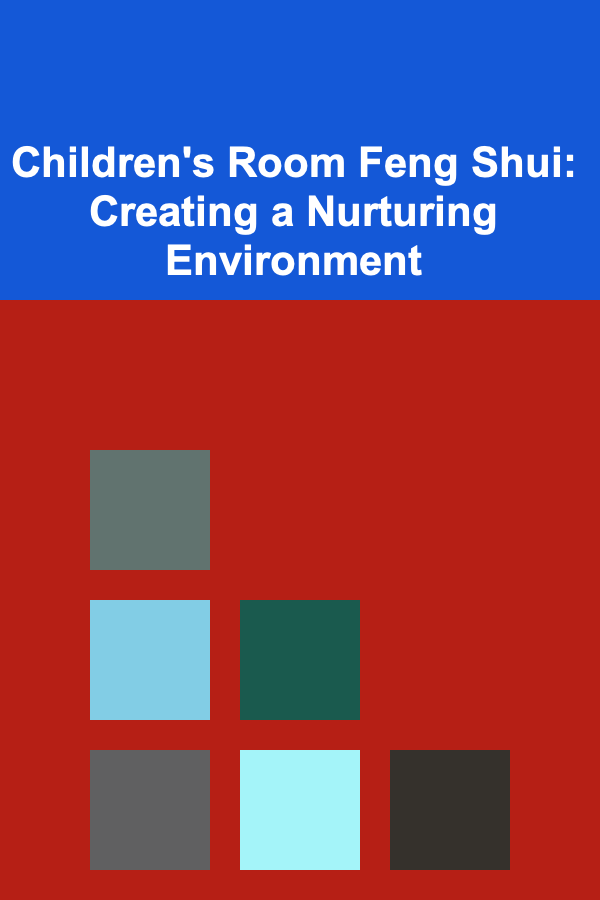
Children's Room Feng Shui: Creating a Nurturing Environment
ebook include PDF & Audio bundle (Micro Guide)
$12.99$7.99
Limited Time Offer! Order within the next:

Feng Shui, an ancient Chinese practice of harmonizing the flow of energy, has been used for thousands of years to create balanced, positive environments in homes, businesses, and public spaces. While Feng Shui is commonly applied to living areas, its principles can be especially powerful in children's rooms. The spaces where children sleep, study, and play can have a profound impact on their development, behavior, and overall well-being. By incorporating the principles of Feng Shui, parents can create nurturing environments that support their child's physical, emotional, and intellectual growth.
In this article, we will explore how to apply Feng Shui in a child's room, focusing on optimizing their space for sleep, creativity, concentration, and emotional health. From the proper positioning of furniture to the strategic use of colors and elements, we'll provide an in-depth guide to creating a room that encourages positive energy and a sense of harmony.
1. The Fundamentals of Feng Shui for Children
Feng Shui is based on the idea that everything in the environment has energy, or Chi, and that this energy flows in ways that can either support or hinder a person's well-being. When designing a child's room with Feng Shui in mind, the goal is to create a space that promotes good health, restful sleep, intellectual growth, creativity, and a sense of emotional security. The child's energy, needs, and development stage should guide the design and arrangement of the room.
Key principles to consider when applying Feng Shui to a child's room include:
- Balance and Harmony: A balanced room helps create a peaceful and supportive environment for your child's growth.
- Good Qi Flow: Qi, or energy, should flow freely without obstacles like clutter or heavy furniture blocking pathways.
- Proper Elements and Colors: Different elements (Wood, Fire, Earth, Metal, and Water) and colors have distinct effects on energy and mood, and they should be thoughtfully used in a child's room to foster appropriate development.
- Personalization: The child's interests and preferences should play a role in how the room is designed. Feng Shui encourages personalizing spaces to make them feel safe, comforting, and stimulating for the child.
2. Room Layout: The Power of the Bed and Furniture Placement
The layout of a child's room is one of the most important aspects of Feng Shui. In particular, the positioning of the bed is critical for the quality of sleep, a vital component of childhood development. Proper placement of the furniture creates a sense of security, comfort, and ease, while also encouraging positive energy flow throughout the room.
2.1 The Bed: The Centerpiece of the Room
In Feng Shui, the bed is the most crucial piece of furniture, especially for children. A well-placed bed can encourage restful sleep, support emotional stability, and contribute to overall well-being.
- Positioning the Bed : The bed should be positioned in the command position, which means it should have a clear view of the door without being directly in line with it. This allows the child to feel safe and in control of their environment. Ideally, the bed should be against a solid wall for support, with no windows behind it, which can create vulnerability and disturb sleep.
- Avoiding the Door: Avoid placing the bed directly in front of or below a door. The door represents the entrance of Qi, and being directly aligned with it may lead to restlessness or an overactive mind during sleep.
- Headboard Support: A solid headboard is essential in Feng Shui as it provides physical and emotional support. A sturdy, supportive headboard promotes stability and security, helping the child to feel protected and grounded.
2.2 Furniture Placement for Flow
In addition to the bed, the positioning of other furniture in the room can either enhance or disrupt the room's energy. To encourage smooth Qi flow, arrange furniture so that it doesn't block pathways or create tight spaces. Here are some tips:
- Avoid Clutter: Clutter creates stagnant energy and can overwhelm the room, leading to a feeling of chaos and discomfort. Keep the room organized, with toys and belongings neatly stored away.
- Furniture Height: Avoid placing too much heavy furniture in the room, especially in areas where the child spends time playing or sleeping. Heavy furniture can create a sense of oppression, whereas lighter furniture promotes more uplifting energy.
- Balance the Space: Ensure that the room feels balanced. If the bed is on one side, try to balance it with bookshelves, storage units, or chairs on the opposite side. This symmetrical arrangement creates harmony and flow.
3. Color and Element Choices: Supporting Growth and Development
Colors and elements play a significant role in the overall energy of a room. Different colors have distinct psychological and energetic effects that can impact your child's mood, behavior, and development.
3.1 Choosing the Right Colors
Each color is associated with a particular element in Feng Shui, and choosing the right color palette for your child's room can help nurture specific qualities. Here are some color suggestions based on the child's developmental needs:
- Soft Pastels and Earthy Tones (Earth Element): Soft pastel colors like pale yellow, beige, and light green are nurturing and soothing. These colors support emotional health, making them great for babies, toddlers, or children who need stability and comfort. Earth tones promote feelings of groundedness and security.
- Warm Colors (Fire Element): Warm colors such as red, orange, and yellow stimulate creativity and enthusiasm. These colors work well in play areas or study zones to inspire energy, focus, and joy. However, avoid using too much red, as it can be overwhelming or overstimulating.
- Cool Colors (Water and Metal Elements): Cool tones like blues, purples, and grays promote calmness and relaxation. These colors are ideal for the sleeping area, as they can help children relax and sleep peacefully. Purple is also associated with creativity and spiritual growth.
- White and Neutrals (Metal Element): White and light neutrals are clean, fresh, and stimulating for clarity of thought. These colors can be used in areas meant for study or intellectual development, such as desks or reading corners.
3.2 Incorporating Feng Shui Elements
In addition to colors, the five elements of Feng Shui---Wood, Fire, Earth, Metal, and Water---should be balanced to promote harmony. Here's how to incorporate these elements:
- Wood: Wood represents growth, vitality, and creativity. Add plants, wooden furniture, or green tones to stimulate growth and promote creativity. A few potted plants can also improve air quality and create a more vibrant atmosphere.
- Fire: The Fire element symbolizes passion, energy, and stimulation. To incorporate Fire, use red or orange colors, or add a lamp, candles, or other lighting features. However, it's important to use Fire elements sparingly to avoid overstimulation.
- Earth: Earth provides stability and nourishment. Earthy tones, ceramic items, and crystals can be used to create a grounded and stable environment. Earth elements are particularly important in creating a nurturing space for sleep and rest.
- Metal: Metal symbolizes clarity, precision, and focus. Include metallic decor, such as metal frames, sculptures, or items in white, silver, or gold, especially in study areas or rooms where focus is needed.
- Water: Water represents flow, wealth, and abundance. Incorporate water through mirrors, a water feature, or blue/black tones. Water helps promote a calming and peaceful environment.
4. Creating Zones: Functional Spaces for Different Activities
A child's room serves many purposes: it is a place to sleep, play, study, and create. To encourage the natural flow of Qi, it's important to create different zones in the room, each serving a specific purpose. This ensures that the child has dedicated spaces for rest, learning, and creativity, which enhances both development and emotional well-being.
4.1 Sleep Zone
The sleep zone is the most critical area for a child's health and energy. As previously mentioned, this zone should have the bed positioned in the command position, ideally against a solid wall with no direct alignment to the door. This ensures restful sleep, which is essential for growth and development.
4.2 Study and Creativity Zone
The study or creativity zone is where children focus on learning, reading, or engaging in creative activities. The desk should be placed in an area with good lighting and minimal distractions. Ideally, it should face a wall or the door, so the child feels secure and can focus on their work. Encourage creativity by using bright colors and inspiring artwork.
4.3 Play Zone
The play zone is where the child can express creativity and enjoy free time. To create a balanced play area, use soft, non-cluttered furniture and play items that stimulate imagination without overwhelming the space. Ensure this area is open and spacious, allowing the child to move freely and engage in activities without feeling restricted.
5. Additional Tips for a Harmonious Children's Room
- Personalized Touches: Include personal items like the child's favorite toys, books, or artwork. This gives them a sense of ownership and emotional connection to their space.
- Natural Light: Natural light is essential for good health and energy. Maximize the room's exposure to sunlight during the day, but make sure to use light-blocking curtains or shades for the night to promote restful sleep.
- Avoid Electronics in the Bedroom: Electronic devices, especially screens, emit electromagnetic radiation and can interfere with sleep. Avoid placing electronic devices in the sleep zone, and limit screen time before bed.
6. Conclusion
Feng Shui offers valuable tools for parents seeking to create a nurturing and harmonious environment for their children. By considering the room's layout, colors, elements, and furniture placement, parents can foster a space that supports healthy development, restful sleep, emotional security, and intellectual growth. A well-balanced children's room not only enhances the child's well-being but also creates a space where positive energy flows, supporting both the child's current needs and future potential. By using Feng Shui principles thoughtfully and intentionally, parents can create an environment that nurtures the whole child.

How to Designate a Study Area with Organized Materials
Read More
How to Keep Toy Organization Fun and Engaging
Read More
How to Make Your Home Look Expensive with Budget-Friendly Tips
Read More
How to Use Energy-Efficient Settings on Your Appliances
Read More
How To Become a Master Bird Watcher
Read More
10 Tips for Coloring Therapy: Stress Relief and Relaxation
Read MoreOther Products

How to Designate a Study Area with Organized Materials
Read More
How to Keep Toy Organization Fun and Engaging
Read More
How to Make Your Home Look Expensive with Budget-Friendly Tips
Read More
How to Use Energy-Efficient Settings on Your Appliances
Read More
How To Become a Master Bird Watcher
Read More